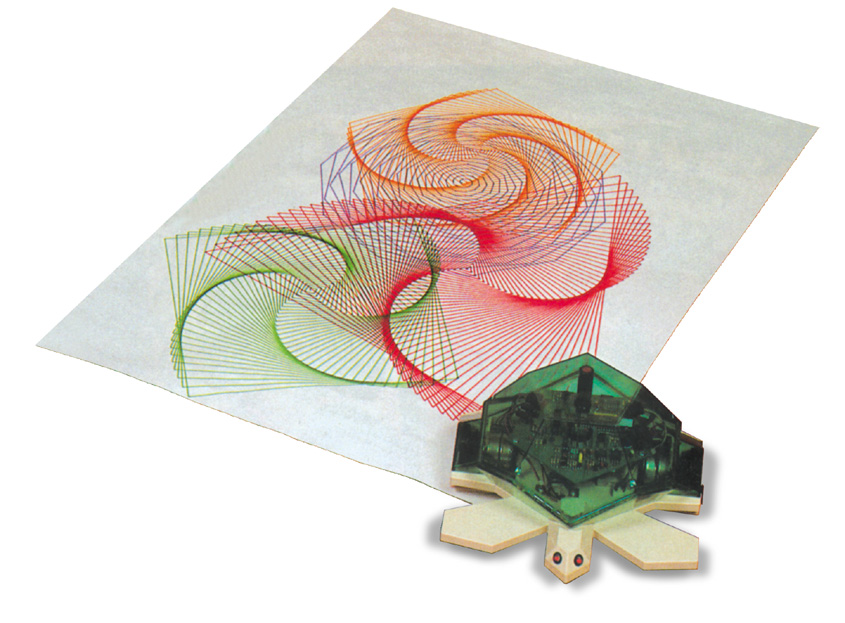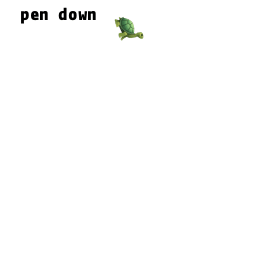|
Logo (programming Language)
Logo is an educational programming language, designed in 1967 by Wally Feurzeig, Seymour Papert, and Cynthia Solomon. ''Logo'' is not an acronym: the name was coined by Feurzeig while he was at Bolt, Beranek and Newman, and derives from the Greek ''logos'', meaning ''word'' or ''thought''. A general-purpose language, Logo is widely known for its use of turtle graphics, in which commands for movement and drawing produced line or vector graphics, either on screen or with a small robot termed a turtle. The language was conceived to teach concepts of programming related to Lisp and only later to enable what Papert called " body-syntonic reasoning", where students could understand, predict, and reason about the turtle's motion by imagining what they would do if they were the turtle. There are substantial differences among the many dialects of Logo, and the situation is confused by the regular appearance of turtle graphics programs that are named Logo. Logo is a multi-paradigm adaptati ... [...More Info...] [...Related Items...] OR: [Wikipedia] [Google] [Baidu] |
Procedural Programming
Procedural programming is a programming paradigm, derived from imperative programming, based on the concept of the '' procedure call''. Procedures (a type of routine or subroutine) simply contain a series of computational steps to be carried out. Any given procedure might be called at any point during a program's execution, including by other procedures or itself. The first major procedural programming languages appeared circa 1957–1964, including Fortran, ALGOL, COBOL, PL/I and BASIC. Pascal and C were published circa 1970–1972. Computer processors provide hardware support for procedural programming through a stack register and instructions for calling procedures and returning from them. Hardware support for other types of programming is possible, but no attempt was commercially successful (for example Lisp machines or Java processors). Procedures and modularity Modularity is generally desirable, especially in large, complicated programs. Inputs are usually ... [...More Info...] [...Related Items...] OR: [Wikipedia] [Google] [Baidu] |
Koch Curve
The Koch snowflake (also known as the Koch curve, Koch star, or Koch island) is a fractal curve and one of the earliest fractals to have been described. It is based on the Koch curve, which appeared in a 1904 paper titled "On a Continuous Curve Without Tangents, Constructible from Elementary Geometry" by the Swedish mathematician Helge von Koch. The Koch snowflake can be built up iteratively, in a sequence of stages. The first stage is an equilateral triangle, and each successive stage is formed by adding outward bends to each side of the previous stage, making smaller equilateral triangles. The areas enclosed by the successive stages in the construction of the snowflake converge to \tfrac times the area of the original triangle, while the perimeters of the successive stages increase without bound. Consequently, the snowflake encloses a finite area, but has an infinite perimeter. Construction The Koch snowflake can be constructed by starting with an equilateral triangle, ... [...More Info...] [...Related Items...] OR: [Wikipedia] [Google] [Baidu] |
Functional Programming
In computer science, functional programming is a programming paradigm where programs are constructed by applying and composing functions. It is a declarative programming paradigm in which function definitions are trees of expressions that map values to other values, rather than a sequence of imperative statements which update the running state of the program. In functional programming, functions are treated as first-class citizens, meaning that they can be bound to names (including local identifiers), passed as arguments, and returned from other functions, just as any other data type can. This allows programs to be written in a declarative and composable style, where small functions are combined in a modular manner. Functional programming is sometimes treated as synonymous with purely functional programming, a subset of functional programming which treats all functions as deterministic mathematical functions, or pure functions. When a pure function is called wi ... [...More Info...] [...Related Items...] OR: [Wikipedia] [Google] [Baidu] |
Kinesthetic
Proprioception ( ), also referred to as kinaesthesia (or kinesthesia), is the sense of self-movement, force, and body position. It is sometimes described as the "sixth sense". Proprioception is mediated by proprioceptors, mechanosensory neurons located within muscles, tendons, and joints. Most animals possess multiple subtypes of proprioceptors, which detect distinct kinematic parameters, such as joint position, movement, and load. Although all mobile animals possess proprioceptors, the structure of the sensory organs can vary across species. Proprioceptive signals are transmitted to the central nervous system, where they are integrated with information from other sensory systems, such as the visual system and the vestibular system, to create an overall representation of body position, movement, and acceleration. In many animals, sensory feedback from proprioceptors is essential for stabilizing body posture and coordinating body movement. System overview In vertebrates, limb ve ... [...More Info...] [...Related Items...] OR: [Wikipedia] [Google] [Baidu] |
Turtle (robot)
Turtles are a class of educational robots designed originally in the late 1940s (largely under the auspices of researcher William Grey Walter) and used in computer science and mechanical engineering training. These devices are traditionally built low to the ground with a roughly hemispheric (sometimes transparent) shell and a power train capable of a very small turning radius. The robots are often equipped with sensor devices which aid in avoiding obstacles and, if the robot is sufficiently sophisticated, allow it some perception of its environment. Turtle robots are commercially available and are common projects for robotics hobbyists. Turtle robots are closely associated with the work of Seymour Papert and the common use of the Logo programming language in computer education of the 1980s. Turtles specifically designed for use with Logo systems often come with pen mechanisms allowing the programmer to create a design on a large sheet of paper. The original Logo turtle, built by P ... [...More Info...] [...Related Items...] OR: [Wikipedia] [Google] [Baidu] |
Vector Graphics
Vector graphics is a form of computer graphics in which visual images are created directly from geometric shapes defined on a Cartesian plane, such as points, lines, curves and polygons. The associated mechanisms may include vector display and printing ''hardware'', vector ''data models'' and file formats, as well as the ''software'' based on these data models (especially graphic design software, computer-aided design, and geographic information systems). Vector graphics is an alternative to raster or bitmap graphics, with each having advantages and disadvantages in specific situations. While vector hardware has largely disappeared in favor of raster-based monitors and printers, vector data and software continues to be widely used, especially when a high degree of geometric precision is required, and when complex information can be decomposed into simple geometric primitives. Thus, it is the preferred model for domains such as engineering, architecture, surveying, 3D ren ... [...More Info...] [...Related Items...] OR: [Wikipedia] [Google] [Baidu] |
Turtle Graphics
In computer graphics, turtle graphics are vector graphics using a relative cursor (the "turtle") upon a Cartesian plane (x and y axis). Turtle graphics is a key feature of the Logo programming language. Overview The turtle has three attributes: a location, an orientation (or direction), and a pen. The pen, too, has attributes: color, width, and on/off state (also called ''down'' and ''up''). The turtle moves with commands that are relative to its own position, such as "move forward 10 spaces" and "turn left 90 degrees". The pen carried by the turtle can also be controlled, by enabling it, setting its color, or setting its width. A student could understand (and predict and reason about) the turtle's motion by imagining what they would do if they were the turtle. Seymour Papert called this "body syntonic" reasoning. A full turtle graphics system requires control flow, procedures, and recursion: many turtle drawing programs fall short. From these building blocks one can buil ... [...More Info...] [...Related Items...] OR: [Wikipedia] [Google] [Baidu] |
Bolt, Beranek And Newman
Raytheon BBN (originally Bolt Beranek and Newman Inc.) is an American research and development company, based next to Fresh Pond in Cambridge, Massachusetts, United States. In 1966, the Franklin Institute awarded the firm the Frank P. Brown Medal, in 1999 BBN received the IEEE Corporate Innovation Recognition, and on 1 February 2013, BBN was awarded the National Medal of Technology and Innovation, the highest honors that the U.S. government bestows upon scientists, engineers and inventors, by President Barack Obama. It became a wholly owned subsidiary of Raytheon in 2009. History BBN has its roots in an initial partnership formed on 15 October 1948 between Leo Beranek and Richard Bolt, professors at the Massachusetts Institute of Technology. Bolt had won a commission to be an acoustic consultant for the new United Nations permanent headquarters to be built in New York City. Realizing the magnitude of the project at hand, Bolt had pulled in his MIT colleague Beranek for he ... [...More Info...] [...Related Items...] OR: [Wikipedia] [Google] [Baidu] |
Educational Programming Language
An educational programming language is a programming language that is designed mostly as an instrument for learning, and less as a tool for writing programs to perform work. Types of educational programming languages Assembly languages Originally, machine code was the first and only way to program computers. Assembly language was the next type of language used; thus, is one of the oldest families of computer languages in use today. Many dialects and implementations are available, usually some for each computer processor architecture. It is very basic and termed a low level programming language. It is one of the more difficult languages to work with being untyped and rigid, but this is how computers work at low level. Several simplified dialects exist for education. Low level languages must be written for a specific processor architecture and cannot be written or taught in isolation without referencing the processor for which it was written. Unlike higher level languages, ... [...More Info...] [...Related Items...] OR: [Wikipedia] [Google] [Baidu] |
Remi Turtlegrafik
The Remi (Gaulish: ''Rēmi'', 'the first, the princes') were a Belgic tribe dwelling in the Aisne, Vesle and Suippe river valleys during the Iron Age and the Roman period. Their territory roughly corresponded the modern Marne and Ardennes and parts of the Aisne and Meuse departments. Name They are mentioned as ''Remi'' by Caesar (mid-1st c. BC) and Pliny (1st c. AD), ''Rhē̃moi'' (Ῥη̃μοι; var. Ῥημοὶ) by Strabo (early 1st c. AD) and Ptolemy (2nd c. AD), ''Remos'' by Tacitus (early 2nd c. AD), ''Rhēmō̃n'' (Ῥημω̃ν) and ''Rhēmoĩs'' (Ῥημοι̃ς) by Cassius Dio (3rd c. AD), and as ''Nemorum'' in the '' Notitia Dignitatum'' (5th c. AD). The Gaulish ethnonym ''Rēmi'' (sing. ''Rēmos'') literally means 'the first ones', that is to say 'the princes'. It stems from a Proto-Celtic form reconstructed as ''*reimos'' ('first, prince, chief'; cf. Old Irish ''rem''- 'in front of', Welsh ''rwyf'' 'prince, chief', Mid. Cornish ''ruif'' 'king'), itself ... [...More Info...] [...Related Items...] OR: [Wikipedia] [Google] [Baidu] |
Boxer (programming Environment)
Boxer most commonly refers to: * Boxer (boxing), a competitor in the sport of boxing *Boxer (dog), a breed of dog Boxer or boxers may also refer to: Animal kingdom * Boxer crab * Boxer shrimp, a small group of decapod crustaceans * Boxer snipe eel, ''Nemichthys curvirostris'' Film and television *Boxer TV Access, a Swedish digital TV provider * ''Boxer'' (1984 film), a 1984 Hindi-language film * ''Boxer'' (2015 film), a 2015 Kannada-language film * ''Boxer'' (2018 film) a 2018 Bengali-language film * ''The Boxer'' (1997 film), a 1997 film starring Daniel Day-Lewis * ''The Boxer'' (1958 film), a 1958 Mexican sports drama film * ''The Boxer'' (2012 film), a 2012 short film starring Paul Barber *''The Boxer'', aka '' Ripped Off'', a 1972 Italian film starring Robert Blake and Ernest Borgnine * ''The Boxers'', a Hong Kong film of 1973 Military *Boxer (armoured fighting vehicle), a European, multi-role, armoured vehicle * Boxer Rebellion, a 1900 armed conflict in China ** Boxer move ... [...More Info...] [...Related Items...] OR: [Wikipedia] [Google] [Baidu] |





